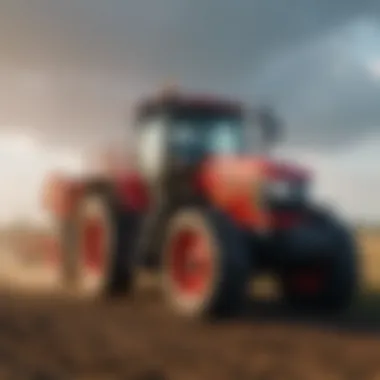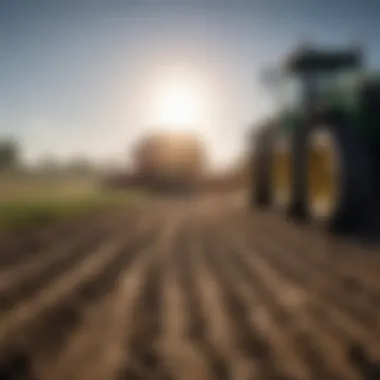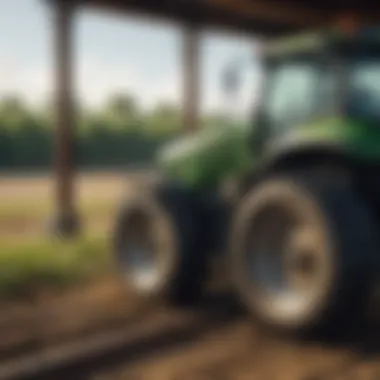Modern Agriculture Machinery: Innovations and Impacts


Intro
Modern agriculture machinery has undergone remarkable transformations in recent decades. This evolution reflects the broader advancements in technology and a rising need for efficiency in farming. By integrating innovative tools and systems, farmers can significantly impact their productivity and sustainability efforts. In this section, we will explore the latest trends shaping agriculture, emphasizing the implications of these developments for both farming practices and environmental stewardship.
Latest Trends in Agriculture
Overview of Current Trends
The agricultural sector has embraced several notable trends driven by technology. Automation continues to be a key focus. With the introduction of drones, farmers can monitor crop health and optimize resource use effectively. The adoption of precision agriculture techniques also stands out. This method uses data analytics to improve decision-making related to planting, watering, and fertilizing. Moreover, the shift towards sustainable practices is evident, as many producers seek to reduce their carbon footprint while maintaining productivity.
Impact of Technology on Farming Practices
The integration of technology into farming practices has transformed how farmers approach cultivation and land management. Machinery such as GPS-guided tractors enables precise planting and cultivation, reducing overlap and resource waste. Additionally, sensors linked to IoT technology provide real-time data on soil moisture and nutrient levels, allowing farmers to make informed decisions regarding irrigation and fertilization.
Furthermore, biotechnology plays a critical role in enhancing crop resilience and yield. Genetically modified organisms (GMOs) can withstand pests and adverse weather conditions, thereby ensuring food security in a changing climate. This technology complements traditional farming methods, creating a synergy that optimizes production and fosters sustainability.
"The adoption of advanced technologies represents a paradigm shift in the agricultural sector, leading to increased efficiency and reduced environmental impacts."
Sustainable Practices: Towards a Greener Future
Importance of Sustainability in Agriculture
Sustainability in agriculture is increasingly vital in the context of global food production challenges. Sustainable practices help conserve resources, protect biodiversity, and minimize pollution. By adopting these practices, farmers contribute not only to their economic viability but also to the health of the planet. Consumers are also more aware of the origins of their food, prompting a shift towards sourcing from environmentally responsible producers.
Methods for Sustainable Farming
Farmers can embrace various methods to enhance sustainability in their operations. Some notable methods include:
- Crop rotation: This practice improves soil health and disrupts pest cycles.
- Organic farming: Utilizing natural inputs can reduce chemical dependency and enhance ecosystem health.
- Water conservation techniques: Innovations such as drip irrigation help optimize water use.
By adopting these techniques, farmers can work towards a more sustainable agricultural model that balances productivity and environmental responsibility.
Gardening Techniques and Tips
Essential Gardening Tools and Equipment
For those engaging in smaller-scale farming or gardening, having the right tools is essential. Key equipment includes:
- Hand trowels: Useful for digging and planting.
- Pruners: Important for trimming and maintaining plant health.
- Soil testers: Help assess soil quality for better crop management.
These tools facilitate effective gardening and contribute to higher yields.
Seasonal Gardening Practices
Implementing seasonal practices is crucial for successful gardening. Understanding when to plant specific crops increases the chances of successful harvests. For instance, cool-season crops such as lettuce and spinach are best sown in early spring or fall. Conversely, warm-season crops like tomatoes and peppers require a later planting in the spring. Seasonal awareness enables gardeners to maximize their productivity and effectively utilize available resources.
By evaluating modern agricultural machinery's innovations and practices, stakeholders can better appreciate the careful balance between efficiency and environmental stewardship. Through continued advancements in technology, the future of agriculture looks promising, offering pathways to increased productivity and sustainability.
Foreword to Modern Agriculture Machinery
The landscape of agriculture has dramatically changed over the past century. The introduction of advanced machinery has played a critical role in this transformation. This section delves into the essence of modern agriculture machinery, examining its definition, purpose, and the historical evolution that shaped it. This analysis will provide a valuable context for understanding how these innovations impact farming practices today.
Definition and Purpose
Modern agriculture machinery refers to the varied equipment used to enhance efficiency in agricultural practices. This includes tractors, harvesters, irrigation systems, and planting machines. The primary purpose of such machinery is to facilitate labor-intensive tasks that would otherwise require significant human effort. By mechanizing these processes, farmers can increase productivity, reduce the time spent on field activities, and ultimately raise crop yields.
The machinery enables precision in tasks such as planting seeds at optimal depths, watering crops with targeted efficiency, and efficiently harvesting large quantities of grains or vegetables. Furthermore, modern machinery often integrates technology that allows for data analysis and monitoring. This capability helps the farmers make informed decisions about their practices, which is essential in today's competitive agricultural landscape.
Historical Context
The history of agricultural machinery dates back many centuries. Initially, farmers relied on hand tools and animal power for their farming activities. The first revolution came with the invention of the plow, which significantly improved soil cultivation. As industrial advancements occurred in the 18th and 19th centuries, machines like the seed drill and mechanical reaper became prevalent. These developments laid the foundation for mechanization as we know it today.
In the 20th century, the introduction of the tractor revolutionized farming. It replaced horses and manual labor, fueling a significant increase in farm productivity. As technology has progressed, modern agriculture machinery has become more sophisticated, incorporating advanced features such as GPS technology to enhance efficiency. These innovations have resulted in the expansion of large-scale farming operations, transforming agriculture from traditional methods into a highly mechanized industry.


The evolution reflects a wider trend where agricultural practices increasingly rely on technology to solve economic and environmental challenges. Understanding this context will provide valuable insights into the continuing innovations that shape modern agriculture.
Types of Modern Agriculture Machinery
Understanding the various types of modern agriculture machinery is crucial in appreciating the technological advancements and their efficacies in the farming sector. Each type of machinery has its unique role, facilitating specific agricultural tasks efficiently, which ultimately enhances productivity and drives cost-effectiveness. This section takes a closer look at different categories of modern machinery, detailing their distinctive features and applications across a spectrum of farming conditions.
Tractors
Engine Types
The engine types in tractors represent a significant aspect of their functionality. They are typically categorized into diesel and gasoline engines, each offering distinct benefits. Diesel engines are renowned for their durability and fuel efficiency, making them a popular choice in heavy-duty applications. On the other hand, gasoline engines generally provide a smoother operation and are often favored for lighter tasks. A unique feature of diesel engines is their higher torque at low RPM, allowing for better performance with heavy loads. However, they may incurr higher initial costs and maintenance expenditures.
Key Features
The key features of tractors encompass several elements that enhance their performance and user-friendliness. Features like four-wheel drive, hydrostatic transmission, and advanced electronic controls contribute significantly to their operational efficiency. A noteworthy characteristic is the integration of GPS technology, which assists in precision farming practices. This capability allows for more accurate field mapping, resulting in optimized input utilization. Nonetheless, some features may increase the overall investment needed and may require specialized training for operators.
Applications in Various Farming Conditions
Tractors are adaptable to a diverse range of farming conditions. Their applications vary from plowing, planting, to harvesting, showcasing versatility across different crops. The ability to attach numerous implements further broadens their utility in various terrains, whether flat or hilly. A defining benefit is their role in reducing manual labor and promoting effective use of time. However, certain environments may pose challenges like soil compaction due to heavy machinery usage, implying careful management is necessary.
Harvesters
Types of Harvesters
Harvesters come in various forms, each tailored to specific types of crops. The primary types include combine harvesters, for grain crops, and forage harvesters, used for silage. A key characteristic of combine harvesters is their multifunctionality, capable of cutting, threshing, and separating grain in a single pass. This efficiency presents a considerable advantage in large-scale operations. However, their higher operational costs may deter smaller farms from acquisition.
Design Innovations
Recent design innovations in harvesters focus on enhancing efficiency and reducing operational costs. Features like adjustable cutting heights and automated feeding systems are becoming standard. These innovations allow operators to optimize performance based on crop conditions. The integration of technology in design has streamlined operations significantly. Yet, the complexity of these systems may necessitate rigorous training for effective use, which can be a barrier to some farmers.
Economic Impact on Crop Yield
The economic impact of harvesters on crop yield is profound. Efficient harvesting can lead to timely collection of crops, reducing losses due to weather or pests. Moreover, the use of advanced harvesters can improve overall crop quality, contributing to better sale prices. A notable advantage is the reduction in labor costs, allowing farmers to allocate resources elsewhere. However, initial investment and maintenance costs can be formidable for smaller-scale operations, limiting accessibility.
Planting Equipment
Seed Drills
Seed drills play a pivotal role in modern planting methods. They ensure consistent seed placement and depth, which is vital for optimal growth. A key characteristic is the ability to operate in various soil conditions without causing excessive disturbance. This helps retain soil structure and moisture. The downside might include dependency on favorable soil conditions, as compacted or overly wet soils can interfere with effective operation.
Transplanters
Transplanters are designed for crops needing careful planting. They allow for the systematic placement of seedlings, ensuring even spacing and depth, which is essential for maximum yield. A unique feature of transplanters is their capability to reduce transplant shock, enhancing seedling survival rates. However, their use may increase production cycles, and some farmers may find them complicated to operate.
Technological Integration in Planting
Technological integration in planting equipment has revolutionized the process. Equipment now often comes equipped with sensors and data analytics capacity, allowing farmers to make informed decisions about planting strategies. This integration enhances precision and reduces resource waste. A notable advantage is the improvement in planting timelines, yet the reliance on technology can also necessitate continuous learning and adaptation by users.
Irrigation Systems
Types of Irrigation Technologies
The types of irrigation technologies vary greatly, encompassing drip, sprinkler, and surface irrigation systems. Drip irrigation is frequently highlighted for its efficiency, delivering water directly to the plants' roots. Sprinkler systems, versatile for various landscape types, ensure coverage over larger areas. Each technology offers unique features that facilitate water conservation in agriculture. However, initial setup costs can be a barrier for some farmers irrespective of long-term savings.
Smart Irrigation
Smart irrigation systems employ technology to optimize water use based on real-time data. These systems can adjust water application based on weather conditions or soil moisture levels. A significant advantage of smart irrigation is the reduction in water waste, promoting sustainability in farming practices. However, dependence on technology may require technical expertise, which could be challenging for traditional farmers.
Water Efficiency in Agriculture
The aspect of water efficiency is increasingly critical in agricultural practices. Implementing state-of-the-art irrigation methods enhances crop yield while conserving water resources. Efficient use of water leads to lower operational costs and less environmental impact. A unique feature of efficient irrigation systems is their ability to scale and adapt to various crop types and growth stages. However, transitioning to more efficient systems can be capital intensive, making it a challenge.
Soil Preparation Tools


Plows
Plows remain fundamental in soil preparation, serving to aerate and cultivate the soil. A defining characteristic of modern plows is their ability to adjust to varied soil conditions and types, optimizing tillage efficiency. However, over-plowing can lead to soil degradation, which emphasizes the importance of judicious use.
Tillers
Tillers are utilized significantly for soil tillage, preparing seedbeds effectively. Their feature of adjustable depth makes them favorable for different cropping systems. While they can enhance soil structure, improper use might lead to compaction, inhibiting root growth.
Impact on Soil Health
The impact of soil preparation tools on soil health is significant. Proper tillage promotes aeration and nutrient mixing, which are critical for plant growth. However, excessive tillage can deplete soil organic matter and disrupt microbial life. Therefore, a balance is required to maintain soil health while maximizing agricultural productivity.
Technological Innovations
Technological innovations play a crucial role in the agricultural landscape, impacting efficiency, productivity, and sustainability. As farming industries adopt advanced tools and methods, they not only improve yields but also address environmental concerns. Technologies such as precision agriculture, automation, and integrated farming systems redefine modern practices, leading to smarter, more sustainable farming.
Precision Agriculture
Precision agriculture involves the use of technology to monitor and manage field variability in crops. Its primary goal is to optimize inputs and maximize outputs, making agriculture more efficient.
GPS Technology
GPS technology has transformed farming, allowing for precise navigation and mapping of fields. With its high accuracy, farmers can apply fertilizers and pesticides more effectively. This not only minimizes waste but also reduces costs. The unique feature of GPS technology is its ability to provide real-time location data. This is very beneficial as it enhances decision-making. However, one disadvantage can be the initial setup costs.
Data Analytics in Farming
Data analytics in farming focuses on gathering and analyzing data from various sources such as sensors and satellite imagery. This has a significant contribution to improving crop management decisions. One key characteristic of data analytics is its ability to provide insights into weather patterns, soil health, and crop performance. Its use helps farmers anticipate challenges and seize opportunities. A unique feature is predictive analytics, which can help forecast yields. Challenges include the complexity of data interpretation and the requirement for technical skills.
Field Mapping Techniques
Field mapping techniques involve creating detailed maps of agricultural lands to better understand soil types and crop conditions. These techniques enhance precision in resource allocation. A key characteristic is the ability to visualize data, making it easier for farmers to identify areas that need attention. This is a popular choice because it supports improved decision-making and long-term planning. However, the downside can be the reliance on technology, which may fail.
Automation and Robotics
Automation and robotics are revolutionizing farming practices. These technologies help in reducing human labor and managing routine tasks effectively.
Robotic Harvesters
Robotic harvesters are designed to automate the process of gathering crops. They significantly increase efficiency, saving time and labor costs. A key characteristic is their ability to operate around the clock, especially during peak harvest periods. This is advantageous for maximizing yields. However, the cost of investment and maintenance can pose a challenge.
Automated Weeding Systems
Automated weeding systems use technology to remove weeds without harming crops. They are a game changer for managing weeds while reducing herbicide use. One major benefit is their ability to perform selective weeding, which enhances biodiversity. A unique feature is the integration with AI to improve precision. On the downside, such systems may not be effective for all types of weeds.
Future Prospects for Automation
The future prospects for automation in agriculture include advancements in machine learning and AI technologies. These innovations could lead to more sophisticated machinery that adapts to various conditions. Automation is a beneficial choice as it promises to increase productivity and reduce reliance on manual labor. However, potential disruptions in the job market and initial technological barriers should be considered.
Integrated Farming Systems
Integrated farming systems combine various agricultural practices and technologies to create a holistic approach to farming. They aim to maximize efficiency and sustainability.
Multi-Technology Approaches
Multi-technology approaches involve using different technologies in tandem to enhance farm operations. This can lead to improved efficiency in resource use. A key characteristic is their adaptability to various farming conditions. This approach is beneficial for diversifying income sources and reducing risks. The downside may include the complexity of managing multiple systems together.
Sustainability in Equipment Usage
Sustainability in equipment usage emphasizes reducing the environmental impact of farming machinery. It is crucial for ensuring long-term viability. One main feature is the focus on energy-efficient technologies, which can lower carbon footprints. This commitment helps farms gain a better reputation, but can lead to higher initial investments in sustainable options.
Case Studies
Case studies provide concrete examples of successful integrated farming practices. They support the understanding of concepts through real-life applications. A key characteristic of case studies is their illustrative nature. They are beneficial for sharing lessons learned and best practices in the industry. However, these cases may not always be transferable to different regions or contexts.


"Technological innovations are not just tools; they are the foundation of future farming success."
Through these technological innovations, the landscape of agriculture is gradually changing, presenting new opportunities and challenges for farmers and stakeholders.
Environmental and Economic Implications
Understanding the environmental and economic implications of modern agriculture machinery is crucial. This section explores how mechanization affects ecosystems and its economic efficiency. These factors significantly influence farming practices and decisions, impacting both yield and sustainability. By assessing these implications, stakeholders can make informed choices that balance productivity with environmental care.
Impact on Ecosystems
Effects on Biodiversity
The impact of modern agriculture machinery on biodiversity cannot be overlooked. Machinery can lead to habitat destruction, which affects local flora and fauna. The conversion of natural land into agricultural fields reduces biodiversity. However, certain machinery innovations aim to lessen these effects. For instance, precision agriculture can tailor farming practices to minimize land disturbance. This focus on habitat conservation holds potential advantages in maintaining ecological balance.
Resource Depletion
Another key aspect is resource depletion. The heavy use of machinery often leads to the over-extraction of resources, primarily soil and water. Intensive farming practices can deplete the soil's nutrients, making it less fertile over time. A major characteristic of this issue is its long-term impact on agricultural productivity. Sustainable machinery options that promote soil conservation are gaining popularity, but they also require initial financial investment and adaptation to new practices.
Erosion and Sustainability
Erosion is a significant challenge associated with modern farming practices. The heavy machinery often compact the soil, leading to increased runoff and erosion. Sustainable practices aim to mitigate this through techniques such as reduced tillage and cover cropping. The focus on sustainability is appealing as it promotes long-term soil health and ecosystem resilience. However, these approaches may not always be feasible or cost-effective for every farmer.
Economic Efficiency
Economic efficiency is vital in evaluating the overall success of agricultural practices. By analyzing costs and benefits, farmers can determine the value of technological investments in machinery.
Cost-Benefit Analysis
A cost-benefit analysis serves as a practical tool to measure the financial impact of agricultural machinery. It enables farmers to weigh upfront costs against potential gains. The key characteristic here is the detailed examination of economic outcomes. This method is beneficial as it provides a clear framework for decision-making. However, challenges include variables like market fluctuations and changing input costs, which can influence long-term results.
Return on Investment in Machinery
Assessing the return on investment in machinery is crucial for businesses. A positive ROI indicates that the investment is yielding sufficient profits. The unique feature of this evaluation is its ability to highlight which types of machinery provide the most economic benefits. Regardless of its advantages, farmers may face challenges when upgrading equipment without jeopardizing cash flow or financial stability.
Market Trends
Understanding market trends is essential for navigating the agricultural machinery landscape. Farmers must be aware of shifts, such as the rise of electric tractors or automated systems. These trends offer insights into potential future investments. Key characteristics of market trends include data analysis and consumer behavior insights. They help farmers make strategic choices that align with technological advancements and sustainability goals. However, rapid changes can create uncertainty in long-term planning.
Challenges and Future Directions
The exploration of challenges and future directions related to modern agriculture machinery is crucial. It provides insights into the obstacles that the agricultural sector faces in adopting new technologies. Furthermore, it offers a glimpse into future innovations that might reshape this sector. Understanding these challenges promotes better strategies for adoption and maximization of the benefits of modern machinery. This analysis can lead to better decision-making for farmers, policymakers, and industry stakeholders.
Barriers to Adoption
Financial Constraints
Financial constraints significantly hinder the adoption of modern machinery. Many farmers face limitations in accessing capital needed for purchasing advanced equipment. The key characteristic of financial constraints is the high initial cost of machinery. This challenge makes new technology seem less beneficial for smaller farms or individuals with limited financial resources. The unique feature of financial constraints is that they affect the long-term planning of farmers. Investing in modern machinery can mean taking on large debts. This can lead to stress and operational difficulties. In summary, overcoming these financial hurdles is essential for broader adoption of agricultural innovations.
Skill Gaps
Skill gaps represent another critical challenge. The agricultural industry is evolving at a rapid pace, and many workers may not possess the necessary skills to operate new machinery. The key characteristic of skill gaps lies in the rapid technological advancements that outpace workforce training programs. This issue is a considerable disadvantage because it can lead to inefficient use of machinery, both in operation and maintenance. Farmers might feel hesitant to adopt machinery that they do not know how to operate efficiently. Thus, addressing skill gaps through education and training programs is vital for increasing adoption rates in modern agriculture.
Regulatory Hurdles
Regulatory hurdles can also impede the progress in agricultural mechanization. These challenges often arise from the need to comply with safety, environmental, and operational regulations. The key characteristic of these hurdles is their complexity, which can create a daunting landscape for farmers. Regulatory hurdles can sometimes lead to delays in machinery introduction or increased compliance costs. Moreover, the unique feature of regulatory challenges is that they can vary greatly based on region and local government policies. Although regulations aim to promote safe and sustainable practices, they can become barriers instead. Understanding and navigating these regulations is crucial for farmers aiming to adopt modern equipment effectively.
Future Trends
Emerging Technologies
Emerging technologies such as drones and autonomous systems are reshaping the landscape of modern agriculture machinery. These innovations enhance efficiency and precision in farming operations. The key characteristic of emerging technologies is their ability to optimize crop management. This is a beneficial aspect because better decision-making tools can help in resource allocation. The unique feature is the integration of artificial intelligence and machine learning, enabling real-time data analysis for improved outcomes. However, the integration of these technologies can come with challenges, such as compatibility with existing systems.
Global Perspectives on Mechanization
The global perspective on mechanization illustrates diverse approaches in different countries. Various regions adopt mechanization at varying paces influenced by economic and technological factors. The key characteristic is the contrast between developed and developing nations in terms of agricultural machinery adoption. Understanding these differences sheds light on global market trends. Additionally, the unique feature lies in the adaptation of technologies to local needs and conditions, promoting sustainable practices worldwide. This approach can facilitate knowledge transfer and innovation diffusion across borders.
Anticipated Industry Changes
Anticipated changes in the agricultural machinery industry are essential to monitor for future developments. Factors such as sustainability, climate change, and consumer preferences will likely drive innovations. The key characteristic of these changes is the increasing demand for eco-friendly alternatives in equipment. This is a beneficial trend as it promotes environmental consciousness and responsible farming practices. Furthermore, the unique feature is the integration of circular economy principles in machinery design, focusing on lifecycle management and resource efficiency. This shift not only transforms production methods but also aligns agriculture with broader environmental goals.







